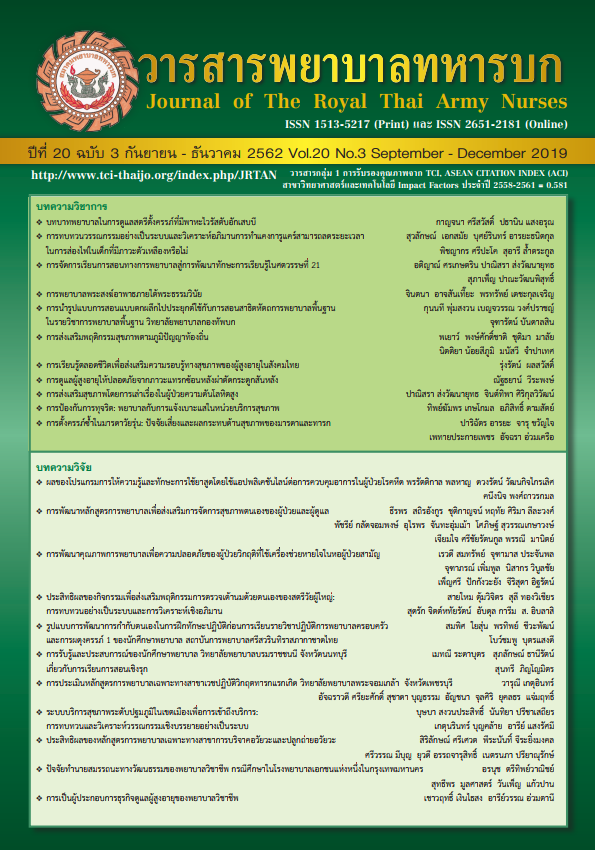Factors Correlated with Instent Restenosis in Coronary Heart Disease Patients
Keywords:
Coronary Heart Disease, Instent RestenosisAbstract
This research aimed to investigate the factors correlated with instent restenosis in coronary heart disease patients. Population is patients with instent in coronary heart disease at Phramongkutklao Hospital between September 2018 - February 2019. The materials of research contain with 1) biosocial factors questionnaire and 2) self - healthcare behavior questionnaire. Data was analyzed by descriptive statistics, including mean, standard deviation and percentages and also inferential statistics by using chi-square test in 38 cases , odds ratio, and logistic regression. The findings revealed that the biosocial and self - healthcare behavior factors were significantly associated with instent restenosis in coronary heart disease patients at α.05 significant level. ; the patient with diabetes mellitus (OR = 2.14 , 95% CI:1.01-4.51), family history of coronary heart disease (OR = 6.21, 95% CI:2.74-14.09), members of family smoking (OR = 5.99, 95% CI: 2.43-14.73), excess body mass index (OR = 3.09, 95% CI: 1.43-6.63), excess waist circumference (OR = 3.87, 95% CI: 1.72-8.74), self - healthcare behavior include food consumption behavior (OR = 3.87, 95% CI: 1. 72-8.74), physical activity and adequate sleep (OR = 12.00, 95% CI: 5.05-28.50), therapeutic adherence (OR = 25.06, 95% CI: 2.97-211.50), smoking and alcohol consumption behavior (OR = 8.33, 95% CI: 1.55-44.95) and stress management (OR = 3.96, 95% CI: 1.77-8.89)
Downloads
References
2. Serruys, P.W., Morice, M.,C., Kappetein, P., Colombo, A., Holmes, D, Mack, M., et al. Percutaneous coronary intervention versus coronary-artery bypass grafting for severe coronary artery disease. The New England Journal of Medicine. 2009; 360(10), 961-972.
3. Hengrussamee K. Kehasukcharoen W. Chapter 4 Percutaneous coronary intervention in STEMI patients. In: Central chest institute of Thailand. Standard of care and referral patients with acute coronary syndrome. Bangkok: Suwit; P20-31.; 2012. (In Thai).
4. Cardiac Catheterization Lab. PMKHeartcenter. Phramongkutklao Hospital.; (2017).
5. Balghith, M., Alghamdi, A.M., Ayoub, K.M., Saleh, A.A., Aziz, M., Algahtany, M., et al. Stent thrombosis is a major concern in clinical practice: a single Saudi centerexperience. Journal of the Saudi Heart Association. 2013;25, 233-238.
6. Smith, S.C., Benjamin, E.J., Bonow, R.O., Braun, Creager, M.A., Franklin, B.A., et al. AHA/ACCF secondary prevention and risk reduction therapy for patients with coronary and other atherosclerotic vascular disease: Update.
Journal of the American College of Cardiology. 2011; 58(23), 2432-2446.
7. Orem DE. Nursing conceptsof practice. 4th ed. St.Louis: Mosby; 1991.
8. Damrongsin S. Self–Care Behaviors among Patients with Coronary In-stent Restenosis. Journal of The Royal Thai Army Nurese. 2017; 18 (suppl): 220-227. (in Thai)
9. Cassese, S., Byrne, R.A., Tada, T., Pinieck, S., Joner, M., Ibrahim, T., et al. Incidence and Predictors of Restenosis After Coronary Stenting in 10,004 Patients With Surveillance Angiography Heart. 2014; 100(2), 153-159
10. Park, C. and Park, H. Identification of independent r isk factors for restenos is follow ing bare-metal stent implantation: Role of bare-metal stents in the era of drug-eluting stents. Eperimental and Therapeutic Medicine. 2013; 6, 840-846.
11. Saisongkroh W. Khunprasert K. Tangkiatkumjai M. Characteristics of Patients with Recurrent Acute Coronary Syndrome, [dissertation]. Bangkok: Srinakharinwirot University; 2010. (in Thai).
12. Yan-Fang Wan, Xiao-Lima, Chen Yuan, Ling Fei, Jing Yang, and Jun Zhang. Impact of daily lifestyle on coronary heart disease. Experimental and Therapeutic Medicine. 2015; 10(3), 1115–1120.
13. Kunchorn Na Ayuthaya R. Rehabilitation medicine. 2nd Edition. Cardiac Rehabilitation. The Heart Association of Thailand under the Royal Patronage. Bangkok.; 2009. (in Thai).
Downloads
Published
How to Cite
Issue
Section
License
บทความหรือข้อคิดเห็นใดใดที่ปรากฏในวารสารพยาบาลทหารบกเป็นวรรณกรรมของผู้เขียน ซึ่งบรรณาธิการหรือสมาคมพยาบาลทหารบก ไม่จำเป็นต้องเห็นด้วย
บทความที่ได้รับการตีพิมพ์เป็นลิขสิทธิ์ของวารสารพยาบาลทหารบก
The ideas and opinions expressed in the Journal of The Royal Thai Army Nurses are those of the authors and not necessarily those
of the editor or Royal Thai Army Nurses Association.






